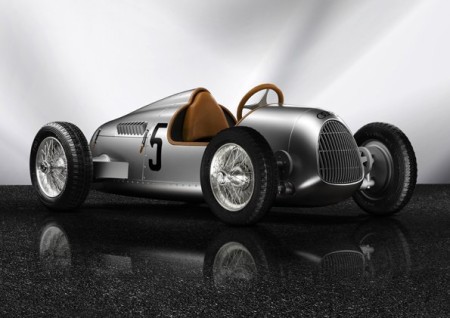
Audi is clearly not content to let parent brand Volkswagen grab all the green headlines with all their new Bluemotion models being unveiled next month at the Frankfurt Motor Show. The crew in Ingolstadt has developed a car with even lower emissions and fuel consumption than the hybrids and diesels. They have announced limited production of the Auto Union Type C pedal car.
The Type C pedal car emits no emissions from operations either directly or remotely other than those that come from the operator. There is no engine and no plug nor are there batteries to replace. The car is built to 1:2 scale from the original 1936 race car and can accommodate drivers up to 1.35m tall. The new car features a seven speed hub gear-set and hydraulic braking and originally appeared in prototype form last fall at the Paris Motor Show. Only 999 of the pedal cars will be built by Audi and if you're interested you should check with your local Audi dealer about availability and pricing. More details are after the jump.
[Source: Audi]
Ingolstadt, 2007-08-03
Auto Union Type C pedal car
Paying homage to the bygone era of motor racing
- Audi brings out the Type C again as a pedal car
- Limited-edition collector's item with only 999 cars built
- Spearheads quattro GmbH's line of lifestyle articles
How did Audi stumble upon this idea? "We needed a highlight for our collection which conveys the brand message and, at the same time, is spectacular enough to find buyers," says Katharina Wicker, Head of Audi design – Lifestyle Articles. And this was how the idea came about to design a pedal car that mirrors the company's heritage at first sight. The Type C Grand Prix racing car provided the ideal blueprint for doing this. The Auto Union Silver Arrow dominated the world of motor racing in 1936, racking up a total of ten Grand Prix victories. Furthermore, the Type C is one of the best-selling heritage models in the range of Audi miniatures. The pedal car will therefore be an exhibition piece for "grown-up" fans too.
The car's execution called for a great deal of technical know-how and creativity. For a start, how large should the pedal car be made? How close should it keep to the original in order to nevertheless demonstrate the quality and workmanship of a true Audi? Which materials are best suited to underlining the Audi brand values of sophistication, progressiveness and sportiness? "The greatest challenge of all was transposing a historical model to a pedal car for children whilst remaining as faithful as possible to the original," reveals Achim Badstübner, director of the Munich design studio that created the first draft designs. Those responsible for the project eventually decided to build the pedal car on a scale of 1:2 to make it large enough to accommodate budding racing drivers up to 1.35 metres tall.
The technical drawings originated in Audi's own tool shop. And in true keeping with the premise "designed by Audi, produced by Audi", special tools and jigs were purpose-designed for the pedal car's manufacture in the Audi tool shop too. The pedal car is made up of over 900 individual parts. It features a hydraulic dual-disc brake and its speed is controlled via the seven-speed hub gear with back-pedalling brake function. Further technical highlights include the aluminium space frame and the body made from aluminium panelling which, just like on the full-size Audi models, symbolise the brand's expertise in the field of lightweight design. The seats, framing and steering wheel have been upholstered in leather by a bag-maker, as in the Audi TT, while the elegant spoke wheels have been custom-made. And because this pedal car seeks to replicate many different aspects of the racing car on which it is modelled, the steering wheel can be removed to make getting in and out easier, just as on the original.
The prototype of the pedal car was unveiled to the public for the first time at the Paris Motor Show in autumn 2006. Visitors to the show were instantly enthralled. "Lots of people even wanted to buy the exhibition model there and then!" recalls Katharina Wicker.
This pedal car, which is limited to a run of 999 models and is far more than just an exclusive collector's item, was an absolute joy to work on for all involved in the project. "It took me straight back to my childhood days. And I wasn't the only one to be seized by that play instinct again," says a delighted Hubert Waltl, Head of Audi Toolmaking. And Achim Badstübner is equally thrilled about the project's success: "Everyone put their heart and soul into this pedal car. And that is something we are all very proud of."
The pedal car can be ordered from the Audi importer for the specific country, who will also be able to provide details regarding the respective price.


Sign in to post
Please sign in to leave a comment.
Continue